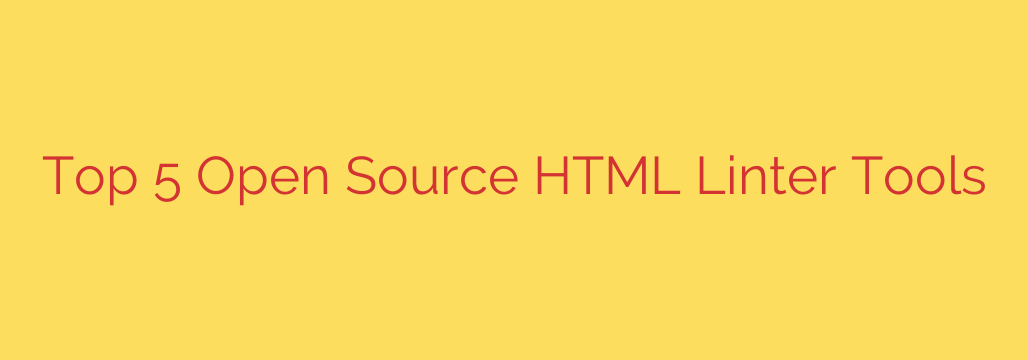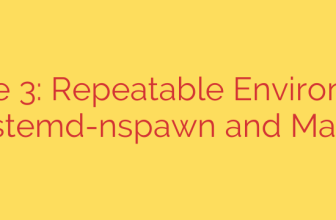
Boost Your Code Quality: The 5 Best Open Source HTML Linter Tools
Writing clean, error-free HTML is the foundation of any great website. While modern browsers are forgiving of small mistakes, invalid markup can lead to unpredictable rendering issues, poor accessibility, and significant challenges for search engine crawlers. This is where an HTML linter becomes an essential tool for any serious web developer.
An HTML linter is an automated tool that analyzes your source code to flag programming errors, bugs, stylistic errors, and suspicious constructs. By integrating a linter into your workflow, you can catch mistakes before they ever make it to production, ensuring your code is robust, maintainable, and standards-compliant.
Why You Need an HTML Linter in Your Workflow
Before diving into the tools, it’s crucial to understand the value they bring. Consistently using a linter provides several key benefits:
- Enforce Coding Standards: Keep your entire team on the same page by enforcing a consistent style guide, making code easier to read and maintain.
- Catch Errors Early: Identify broken syntax, unclosed tags, or deprecated attributes long before they cause cross-browser compatibility headaches.
- Improve Accessibility: Many linters can flag issues that impact users with disabilities, such as missing
altattributes on images or improper use of ARIA roles. - Boost SEO Performance: Clean, valid HTML is easier for search engine bots to parse and index, which can positively impact your site’s visibility.
- Save Time and Reduce Debugging: Automating code review for common errors frees up valuable development time that would otherwise be spent manually hunting for bugs.
Top 5 Open Source HTML Linters to Consider
Here are five of the best open-source tools available today, each with its own unique strengths.
1. HTMLHint
HTMLHint is a highly configurable and powerful static code analysis tool for HTML. It’s a favorite among developers for its flexibility and ease of integration. You can define your own set of rules in a .htmlhintrc file, allowing you to tailor the linting process precisely to your project’s needs.
Key Features:
- Customizable Rules: Choose from over 30 rules covering everything from tag usage and attribute validation to style and accessibility.
- Easy Integration: Works seamlessly with popular code editors like VS Code, Sublime Text, and Atom, as well as build tools like Grunt and Gulp.
- Command-Line Interface (CLI): Can be run from the command line, making it perfect for integration into CI/CD pipelines.
HTMLHint is ideal for teams that need to enforce a specific, custom coding standard across all projects.
2. W3C Markup Validation Service
Considered the gold standard for HTML validation, the W3C Markup Validation Service is an official tool maintained by the World Wide Web Consortium. While not a traditional “linter” that integrates into an IDE, it is the ultimate authority on whether your HTML is compliant with web standards.
Key Features:
- Official Standards Compliance: Checks your code against the official W3C recommendations and standards.
- Multiple Input Methods: You can validate by URL, file upload, or by pasting code directly.
- Detailed Error Reporting: Provides clear, actionable feedback on exactly where your markup fails to meet standards.
Use the W3C validator for final pre-launch checks to ensure your site is technically flawless and universally accessible.
3. SonarQube (with SonarHTML plugin)
SonarQube is a comprehensive open-source platform for continuous inspection of code quality. While it supports over 25 programming languages, its SonarHTML plugin provides robust analysis specifically for HTML. It goes beyond simple syntax checking to find code smells, bugs, and security vulnerabilities.
Key Features:
- In-Depth Analysis: Detects a wide range of issues, including accessibility problems, security risks, and code structure violations.
- Quality Metrics and Tracking: Provides dashboards to track code quality over time, helping you manage technical debt.
- Integration with DevOps Pipelines: Easily integrates with tools like Jenkins, Azure DevOps, and GitHub Actions.
SonarQube is the best choice for enterprise-level projects and teams that need a centralized platform for managing code quality across multiple languages.
4. Dirty Markup
Dirty Markup is a simple yet effective web-based tool that cleans, formats, and validates your HTML, CSS, and JavaScript. It combines the power of other tools like HTML Tidy and CSS Tidy into one easy-to-use interface. Just paste your messy code, and Dirty Markup will instantly clean it up according to your chosen settings.
Key Features:
- Real-Time Cleaning and Validation: Instantly formats and highlights errors as you type or paste code.
- Support for HTML, CSS, and JS: A one-stop-shop for cleaning up your front-end code.
- No Installation Required: As a web-based tool, it’s perfect for quick, one-off code checks without any setup.
Dirty Markup is perfect for developers who need to quickly clean up a snippet of code or reformat a document without installing a full development environment.
5. ESLint with an HTML Plugin
For development teams already using ESLint for their JavaScript, extending its capabilities to handle HTML is a natural fit. Using a plugin like eslint-plugin-html, you can run ESLint rules on the content inside <script> tags within your HTML files.
Key Features:
- Unified Linting Workflow: Manage all your linting (JS and HTML) through a single, familiar tool and configuration file.
- Leverage the ESLint Ecosystem: Gain access to the vast library of ESLint rules and plugins.
- Extracts and Lints Script Tags: Automatically finds and validates the JavaScript embedded within your HTML.
This approach is best for JavaScript-heavy projects where maintaining the quality of inline or embedded scripts is a top priority.
How to Choose the Right HTML Linter
The best tool for you depends on your specific needs:
- For team-wide standard enforcement and IDE integration, HTMLHint is an excellent choice.
- For final, authoritative standards validation, always use the W3C Markup Validation Service.
- For large-scale, multi-language projects needing deep analysis and reporting, SonarQube is unmatched.
- For quick, hassle-free code cleanup, turn to the web-based Dirty Markup.
- For teams already invested in the JavaScript ecosystem, extending ESLint is the most efficient path.
By incorporating one of these powerful open-source linters into your development process, you can significantly improve your code quality, reduce bugs, and build more professional, reliable, and accessible websites.
Source: https://www.linuxlinks.com/best-free-open-source-html-linter-tools/








